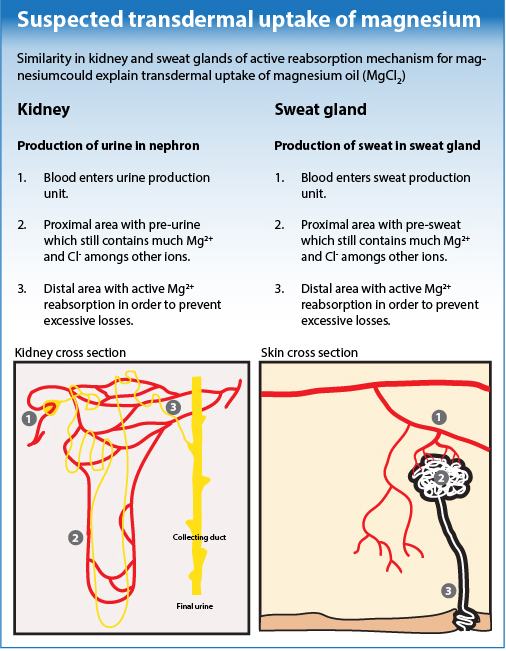Transdermal resorption of magnesium oil: Hypothesis
Because there is as much evidence as discussion about transdermal effect of magnesium chloride and because academic research is lacking, the Magnesium Health Institute aims for scientifically sound research on the effects of dermally administrated magnesium oil (magnesium chloride / MgCl2 ). We developed a 3 step theoretical model that could explain supposed transdermal resorption and we’d liked to know what you think of it:

Step 1. Here we go
It is known that during urine production, regarding magnesium, something special is going on in our kidneys: like many other ions, magnesium is abundantly excreted initially during urine production. In the further course of urine output many valuable components are regained. But in the so called distal tubulus of the nephrons, just before final urine output, there are cells specially dedicated to actively re-absorb Mg. Not only by osmosis, diffusion, e-potential, or other non energy consuming processes; no those cells really actively reabsorb magnesium all the way through their membranes and cell content. It costs energy, but they just do, in order to protect us for magnesium losses!
Step 2. This is the assumption
Another way to loose minerals, including valuable magnesium, is sweating. Because sweat production has similarities with urine production, it would not be surprising if mother nature provided sweat glands with a somehow similar magnesium reabsorption mechanism. Actually there is growing scientific evidence for this assumption.
Step 3. And here’s the catch
Magnesium oil applied on the skin or magnesium chloride in a bath causes magnesium to be available in the distal part of sweat glands, close to the opening. Those ‘actively re-absorbing magnesium-cells’ will detect magnesium and do their job, regardless where the magnesium is coming from: Transdermal uptake.